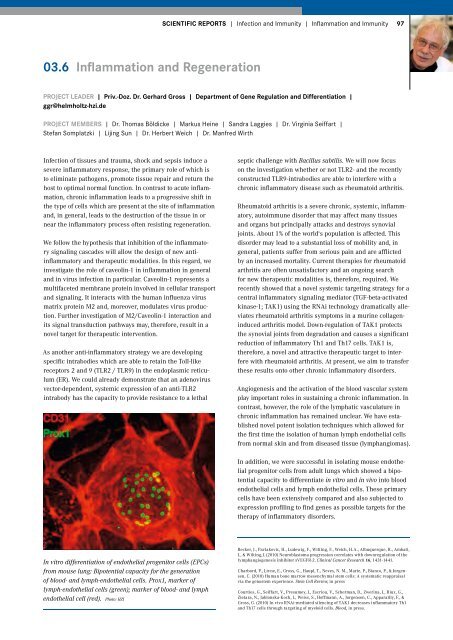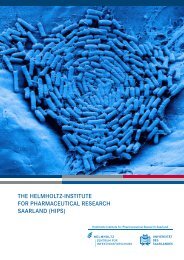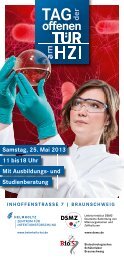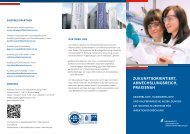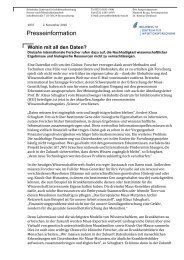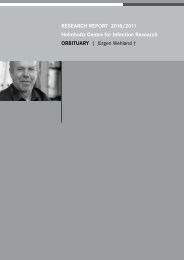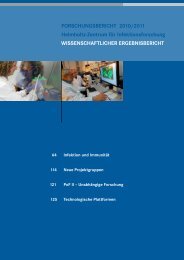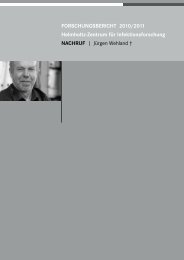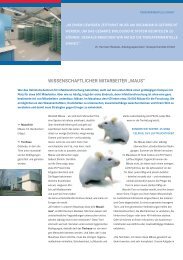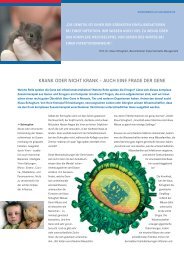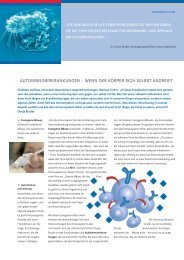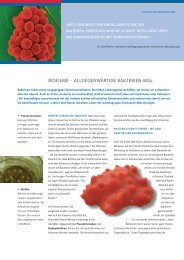Research Report 2010 2011 - Helmholtz-Zentrum für ...
Research Report 2010 2011 - Helmholtz-Zentrum für ...
Research Report 2010 2011 - Helmholtz-Zentrum für ...
Create successful ePaper yourself
Turn your PDF publications into a flip-book with our unique Google optimized e-Paper software.
SCIENTIFIC REPORTS | Infection and Immunity | Infl ammation and Immunity 97<br />
03.6 Inflammation and Regeneration<br />
PROJECT LEADER | Priv.-Doz. Dr. Gerhard Gross | Department of Gene Regulation and Differentiation |<br />
ggr@helmholtz-hzi.de<br />
PROJECT MEMBERS | Dr. Thomas Böldicke | Markus Heine | Sandra Laggies | Dr. Virginia Seiffart |<br />
Stefan Somplatzki | Lijing Sun | Dr. Herbert Weich | Dr. Manfred Wirth<br />
Infection of tissues and trauma, shock and sepsis induce a<br />
severe inflammatory response, the primary role of which is<br />
to eliminate pathogens, promote tissue repair and return the<br />
host to optimal normal function. In contrast to acute inflammation,<br />
chronic inflammation leads to a progressive shift in<br />
the type of cells which are present at the site of inflammation<br />
and, in general, leads to the destruction of the tissue in or<br />
near the inflammatory process often resisting regeneration.<br />
We follow the hypothesis that inhibition of the inflammatory<br />
signaling cascades will allow the design of new antiinflammatory<br />
and therapeutic modalities. In this regard, we<br />
investigate the role of caveolin-1 in inflammation in general<br />
and in virus infection in particular. Caveolin-1 represents a<br />
multifaceted membrane protein involved in cellular transport<br />
and signaling. It interacts with the human influenza virus<br />
matrix protein M2 and, moreover, modulates virus production.<br />
Further investigation of M2/Caveolin-1 interaction and<br />
its signal transduction pathways may, therefore, result in a<br />
novel target for therapeutic intervention.<br />
As another anti-inflammatory strategy we are developing<br />
specific intrabodies which are able to retain the Toll-like<br />
receptors 2 and 9 (TLR2 / TLR9) in the endoplasmic reticulum<br />
(ER). We could already demonstrate that an adenovirus<br />
vector-dependent, systemic expression of an anti-TLR2<br />
intrabody has the capacity to provide resistance to a lethal<br />
septic challenge with Bacillus subtilis. We will now focus<br />
on the investigation whether or not TLR2- and the recently<br />
constructed TLR9-intrabodies are able to interfere with a<br />
chronic inflammatory disease such as rheumatoid arthritis.<br />
Rheumatoid arthritis is a severe chronic, systemic, inflammatory,<br />
autoimmune disorder that may affect many tissues<br />
and organs but principally attacks and destroys synovial<br />
joints. About 1% of the world‘s population is affected. This<br />
disorder may lead to a substantial loss of mobility and, in<br />
general, patients suffer from serious pain and are afflicted<br />
by an increased mortality. Current therapies for rheumatoid<br />
arthritis are often unsatisfactory and an ongoing search<br />
for new therapeutic modalities is, therefore, required. We<br />
recently showed that a novel systemic targeting strategy for a<br />
central inflammatory signaling mediator (TGF-beta-activated<br />
kinase-1; TAK1) using the RNAi technology dramatically alleviates<br />
rheumatoid arthritis symptoms in a murine collageninduced<br />
arthritis model. Down-regulation of TAK1 protects<br />
the synovial joints from degradation and causes a significant<br />
reduction of inflammatory Th1 and Th17 cells. TAK1 is,<br />
there fore, a novel and attractive therapeutic target to interfere<br />
with rheumatoid arthritis. At present, we aim to transfer<br />
these results onto other chronic inflammatory disorders.<br />
Angiogenesis and the activation of the blood vascular system<br />
play important roles in sustaining a chronic inflammation. In<br />
contrast, however, the role of the lymphatic vasculature in<br />
chronic inflammation has remained unclear. We have established<br />
novel potent isolation techniques which allowed for<br />
the first time the isolation of human lymph endothelial cells<br />
from normal skin and from diseased tissue (lymphangiomas).<br />
In addition, we were successful in isolating mouse endothelial<br />
progenitor cells from adult lungs which showed a bipotential<br />
capacity to differentiate in vitro and in vivo into blood<br />
endothelial cells and lymph endothelial cells. These primary<br />
cells have been extensively compared and also subjected to<br />
expression profiling to find genes as possible targets for the<br />
therapy of inflammatory disorders.<br />
In vitro differentiation of endothelial progenitor cells (EPCs)<br />
from mouse lung: Bipotential capacity for the generation<br />
of blood- and lymph-endothelial cells. Prox1, marker of<br />
lymph-endothelial cells (green); marker of blood- and lymph<br />
endothelial cell (red). Photo: HZI<br />
Becker, J., Pavlakovic, H., Ludewig, F., Wilting, F., Weich, H.A., Albuquerque, R., Ambati,<br />
J., & Wilting,J. (<strong>2010</strong>) Neuroblastoma progression correlates with downregulation of the<br />
lymphangiogenesis inhibitor sVEGFR-2. Clinical Cancer <strong>Research</strong> 16, 1431-1441.<br />
Charbord, P., Livne, E., Gross, G., Haupl, T., Neves, N. M., Marie, P., Bianco, P., & Jorgensen,<br />
C. (<strong>2010</strong>) Human bone marrow mesenchymal stem cells: A systematic reappraisal<br />
via the genostem experience. Stem Cell Review, in press<br />
Courties, G., Seiffart, V., Presumey, J., Escriou, V., Scherman, D., Zwerina, J., Riuz, G.,<br />
Zietara, N., Jablonska-Koch, J., Weiss, S., Hoffmann, A., Jorgensen, C., Apparailly, F., &<br />
Gross, G. (<strong>2010</strong>) In vivo RNAi-mediated silencing of TAK1 decreases inflammatory Th1<br />
and Th17 cells through targeting of myeloid cells. Blood, in press.


